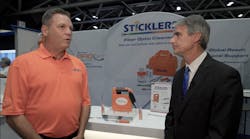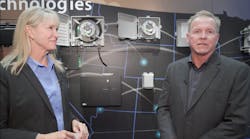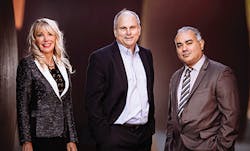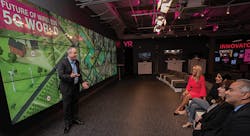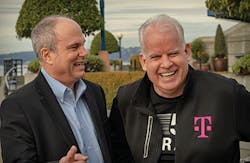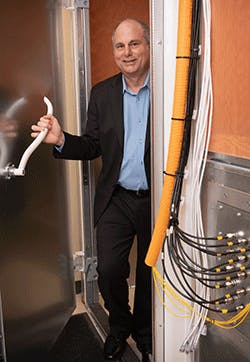TOPIC: Fixed 5G to Mobile 5G
The first "official" 5G networks are using fixed wireless architectures and will basically provide fixed broadband service to residential and small business customers. Many analysts say that we will see 5G millimeter-wave mobile service some time later in 2019, with devices to match.
ISE: How is 5G Americas helping service providers meet that timeline?
Chris Pearson, 5G Americas: 5G Americas has been working for over 4 years with our leading operator and manufacturer members toward the development of first the technical recommendations for 5G networks, then the regulatory policy and spectrum to successfully implement 5G networks. We continue to foster successful implementation of 5G in the Americas by producing important technical white papers as a compass for industry priorities to progress 5G commercial deployments. In addition, 5G Americas and its members participate with government policy makers to ensure that appropriate decisions are made for our region to remain at the forefront of global 5G deployments.
It will be essential for 5G deployments in the US and throughout the Americas region to have more spectrum allocated and for governments to streamline cell siting processes.
Co-founders of the association, Pearson and Vicki Livingston, have steered the organization that began as 3G Americas in 2001 to 4G Americas and now 5G Americas. Here they are joined by current Director of Latin America & the Caribbean, Jose Otero.
TOPIC: Early 5G Challenges
ISE: What challenges will early 5G deployments face? What have you learned from US operators’ early deployments that will help you advise other service providers as they embark on their own 5G launches?
Pearson: Early learnings are that each US operator will initially deploy 5G with a slightly different approach, which can be good for innovation. Operators choose their own path! The lesson for operators is to look at their current spectrum assets, networks density, equipment, and the market that they want to address — and deploy 5G with the strategy that is best for their company. AT&T, Sprint, T-Mobile, and Verizon, all have big 5G plans, and this is good for the US.
We work closely in our technical work groups to address the high-level issues and opportunities such as 3GPP standardization, security, IoT, network enablers, and future spectrum allocations. These technical work groups provide the resulting white papers that address service provider concerns and help them launch 5G. Thus, for 5G Americas, our role is education, advocacy, and outreach, to help not only operators, but the entire mobile wireless ecosystem.
TOPIC: 5G Rollout Pace
5G will be launching by carriers in almost every region in a single year. Like previous generations, it will also be rolled out to major cities first. It will take some time before there’s full national and global coverage.
That said, today’s mobile networks are incredibly complicated — therefore, it takes significant time to upgrade from LTE to 5G NR. Tirias Research believes that the coverage rollout will be twice as fast as 4G, which took about a decade to reach near-global overage.
ISE: What are the challenges to making this happen?
Pearson: The key challenges to 5G commercial success will be spectrum allocation and network density. LTE will provide the mobile wireless foundation for 5G for years to come. However, 5G will be deployed at a very fast pace. Ericsson predicts 1 billion 5G subscribers by 2023, reaching 1.5 billion by year end 2024. There are great competitive and performance incentives for operators to deploy 5G technology. 5G allows access to previously unused mmWave spectrum for cellular services, and can be up to 50% more efficient than 4G technology if all the technical features are deployed.
TOPIC: New Approach to URLLC
With the wide range of unique 5G services, the context of communication will expand to vehicles, high-speed trains, drones, and industrial robots, with the change agent being Ultra-Reliability Low Latency Communications (URLLC). With such advancement, mission-critical applications have stringent communication performance and reliability requirements. Toward that end, 5G Americas recently published the white paper New Services & Applications With 5G Ultra-Reliable Low Latency Communication. It details the principles of achieving URLLC, explains the need for a new approach, and highlights key requirements of URLLC services with an emphasis on technical challenges and solutions.
ISE: Share 2 or 3 of the most important requirements related to the new approach that is outlined in the paper.
Pearson: All communications are important. However, those considered as critical and based on wireless telecommunications standards would support mission-critical applications such as Industrial Internet, Smart Grids, remote surgery, and intelligent transportation systems. The feature sets designed to support these capabilities include a target of 1-millisecond (ms) latency, end-to-end security, and 99.999% reliability.
The 5G Americas white paper, New Services & Applications With 5G Ultra-Reliable Low Latency Communication, describes the significant design, standardization, and engineering challenges that are being overcome to deliver these mission critical networks. Three key requirements for URLLC are low-latency and high-reliability design, unified air interface framework, and strong security.
TOPIC: 5G and Smart Cities
ISE: Talk about 5G’s role in Smart Cities. How do we move to more comprehensive Smart City initiatives given the many network deployment obstacles cities and their provider partners face? Share your greatest learnings about Smart Cities and telecom providers’ interconnected relationship and how it needs to change in the future.
Pearson: Smart Cities represent one of the largest use and business case opportunities for mobile wireless operators. In its study, Accenture Strategy (July 2018) expects the US GDP could be boosted by $500 billion, 3 million new jobs, and offer savings and benefits in excess of $160 billion for local communities. It will be the cities that are smart that will reap the greatest economic and societal benefits for their citizens in areas such as energy efficiency, easing traffic congestion, e-government, and better health care. 5G Americas has learned that it takes a great deal of education and outreach in explaining the benefits of 4G and 5G technologies for cities. For the benefits to occur, cities (just like they did for the power grid, sewage systems, and clean water) need to embrace network density through streamlining cell siting processes. 5G Americas has seen a great deal of progress in the US at the Federal, state, and local levels for cell site processes — and this must continue.
TOPIC: New Radio (NR) – New Frequencies
New frequencies, such as millimeter wave, and new technologies, such as Massive MIMO and Beamforming, mean the complexity of the radio has grown exponentially. The new frequencies offer huge potential in regard to capacity, but the use of these frequencies is challenging due to propagation and penetration characteristics.
ISE: How can this be remedied in the real world — in urban, suburban, and rural, areas?
Pearson: mmWave is a big part of the potential of 5G and will play a key role as it uses spectrum that the cellular industry has never used before. However, let’s remember that 5G is about low-, mid-, and high-band spectrum as well as licensed, shared, and unlicensed spectrum. In tests and trials, mmWave spectrum is showing to be very proficient. One operator in the Americas region reported that their trials support gigabit speeds and millisecond latency. The operator highlighted that with only 100 MHz of mmWave spectrum on a macro-cellular site, they saw speeds of 500 Mbps at 200 feet and less than 100 Mbps at distances of 2,000-2,500 feet. Thus, in essence, a mix of low-, mid-, and high-band spectrum will need to be utilized to address the various requirements of 5G deployments in urban, suburban, and rural areas.
InvisiLight® Solution for Deploying Fiber
April 2, 2022Go to Market Faster. Speed up Network Deployment
April 2, 2022Episode 10: Fiber Optic Closure Specs Explained…
April 1, 2022Food for Thought from Our 2022 ICT Visionaries
April 1, 2022TOPIC: Science and Humanities
Recently, Verizon’s CEO, Hans Vestberg, wrote a blog titled: Why we need both science and humanities for a Fourth Industrial Revolution education. (Vestberg Blog)
He shared this: "The potential automation of many jobs raises some big and tricky questions, but one of these hasn’t received sufficient attention: what is the true purpose of education at a time when machines are getting smarter and smarter?"
To summarize, he said, "The lesson is clear: for technology to deliver on its promise of human betterment, it needs a cultural and moral compass."
ISE: What is your opinion about this, and how do you plan to make a difference in this area?
Pearson: I feel that technology advancements provide a continual opportunity for society to evolve both educationally and socially, though balances must be made in understanding the powerful capabilities of technology and how they affect society at large. Technology advancement, without knowledge and understanding of its effects on mankind, can be a serious concern. Thus, the development of all facets of our social, education, and technology education, is vital to our future. Technology is a powerful force in our everyday lives and this power must be understood by all. STEM (Science, Technology, Engineering, and Mathematics) education is important, but so are the other areas of education that help us learn about human nature, history, and the intricacies of power.
Pearson and 5G Americas Chairman Neville Ray, CTO/EVP, T-Mobile USA, share a laugh at their Board of Governors meeting.
TOPIC: Overlooked Issues
ISE: What should all of us in the Information and Communication Technology (ICT) industry be talking about that we are not?
Pearson: We should be talking about the great amount of innovation in business cases with 5G that is coming down the road but that we don’t yet clearly see. Thus, in a sense "We don’t know, what we don’t know." Remember, it took the Apple iPhone to ignite the smartphone era and Facebook to accelerate social media. Also, 3G and 4G services led to innovation from companies that didn’t even exist only 10-12 years ago that transformed social media, travel, hospitality, and business functions. Likewise, there will be new companies that are enabled by 5G commercial deployments.
TOPIC: Your Role
ISE: What is the most interesting thing about your role? What would you recommend to someone who wants to achieve a high-level position in their career?
Pearson: The most interesting thing about my role is that I get to interact with key influencers in the mobile wireless industry from throughout the world. 5G Americas works closely with operators, vendors, government officials, academia, analysts, media, and standards associations, from across the entire world. Working with such a diverse group of key stakeholders provides me a great perspective of where the industry has been in the past, where it is today, and where it is going in the future.
TOPIC: The Future
ISE: What emerging or disruptive technology excites you the most for the future of the ICT industry? What keeps you up at night about those things?
Pearson: Naturally, I feel 5G will be one of the biggest and most exciting technology disruptors in the future for ICT. 5G will provide hyper-connectivity to all things and all people with high data throughput, low latency, and a diverse Internet of Things architecture. 5G will enable new ways to address long-term societal issues such as transportation, education, and healthcare. I feel that companies will need to evolve or face competition from new companies that find ways to use 5G to address these important markets.
What keeps me up at night is that many regions of the world are embracing the possible societal changes that 5G can provide — whereas other nations consider it only as a technology — not as the enabler that I believe it will be. Countries embracing 5G are providing lots of low-, mid-, and high-band spectrum and are also allowing for network densification. The countries that consider 5G a national priority will reap the great rewards of the technology for their citizens.
TOPIC: You
ISE: What are 3 words that describe you?
Pearson: Smart. Trustworthy. Persistent.
TOPIC: Subtleties
ISE: Share your thoughts about this quote: A boss has the title; a leader has the people. (Source: Simon Sinek)
Pearson: A great quote. A leader has to walk the talk to have their people perform at a high level. A leader must lead by example by their decisions and actions. They won’t always be popular with everyone, but in the end, they will be respected by the people.
TOPIC: Balance
ISE: What do you do to help create work/life balance in your life?
Pearson: I focus my spare time on my family. I put 100% of my effort at work and the same at home with my family. I consider being a father, spouse, son, and brother, as my most important job in this world. I am close with all of my family members.
TOPIC: Myth
ISE: What is the greatest myth about being in an executive position?
Pearson: That everything is always going great. Leaders have the same issues as everyone else. The key to leadership is to provide a good, positive environment and listen to your employees. You have to be a positive
problem-solver who is willing to listen.
TOPIC: Satisfaction
ISE: Please complete this sentence: Satisfaction is ________.
Pearson: Satisfaction is A HAPPY WORK AND FAMILY ENVIRONMENT.
TOPIC: Inspiration
ISE: Please share a quote from someone who inspires you.
"The time is always right to do what is right." -Martin Luther King Jr.
For more information:
Accenture Strategy. https://www.accenture.com/us-en/strategy-index
Tirias Research. https://www.tiriasresearch.com/
The 5G Americas white paper New Services & Applications With 5G Ultra-Reliable Low Latency Communication. http://www.5gamericas.org/files/5115/4169/8314/5G_Americas_URLLLC_White_Paper_Final_11.8.pdf
Vestberg Blog, WEF blog post: "Why we need both science and humanities for a Fourth Industrial Revolution education" by Hans Vestberg, CEO at Verizon Communications, 21 Sep 2018. https://www.linkedin.com/pulse/wef-blog-post-why-we-need-both-science-humanities-fourth-vestberg/

